Managerial Accounting Techniques and Relevancy: A Case Study Analysis
VerifiedAdded on 2021/02/19
|12
|3703
|37
Report
AI Summary
This report provides a comprehensive analysis of Managerial Accounting (MA) techniques, focusing on their application and relevance within contemporary organizations. The study examines a case study of Company A, identifying and evaluating the use of techniques such as the balanced scorecard, total quality management (TQM), and Activity-Based Costing (ABC). The report explores the relevancy of MA systems in modern business environments, emphasizing their role in strategic decision-making and achieving competitive advantages. It contrasts the findings of the case study with another article based on real-life scenarios, highlighting the influence of competition on the adoption of contemporary management accounting practices. The analysis concludes with an assessment of the importance of MA in dynamic environments, the outcomes derived from the techniques and the lessons learned. The report underscores the importance of MA for lower, operational, and top management levels. The study also highlights how companies use MAS to manage external and internal factors, and the importance of strategic considerations in their application.
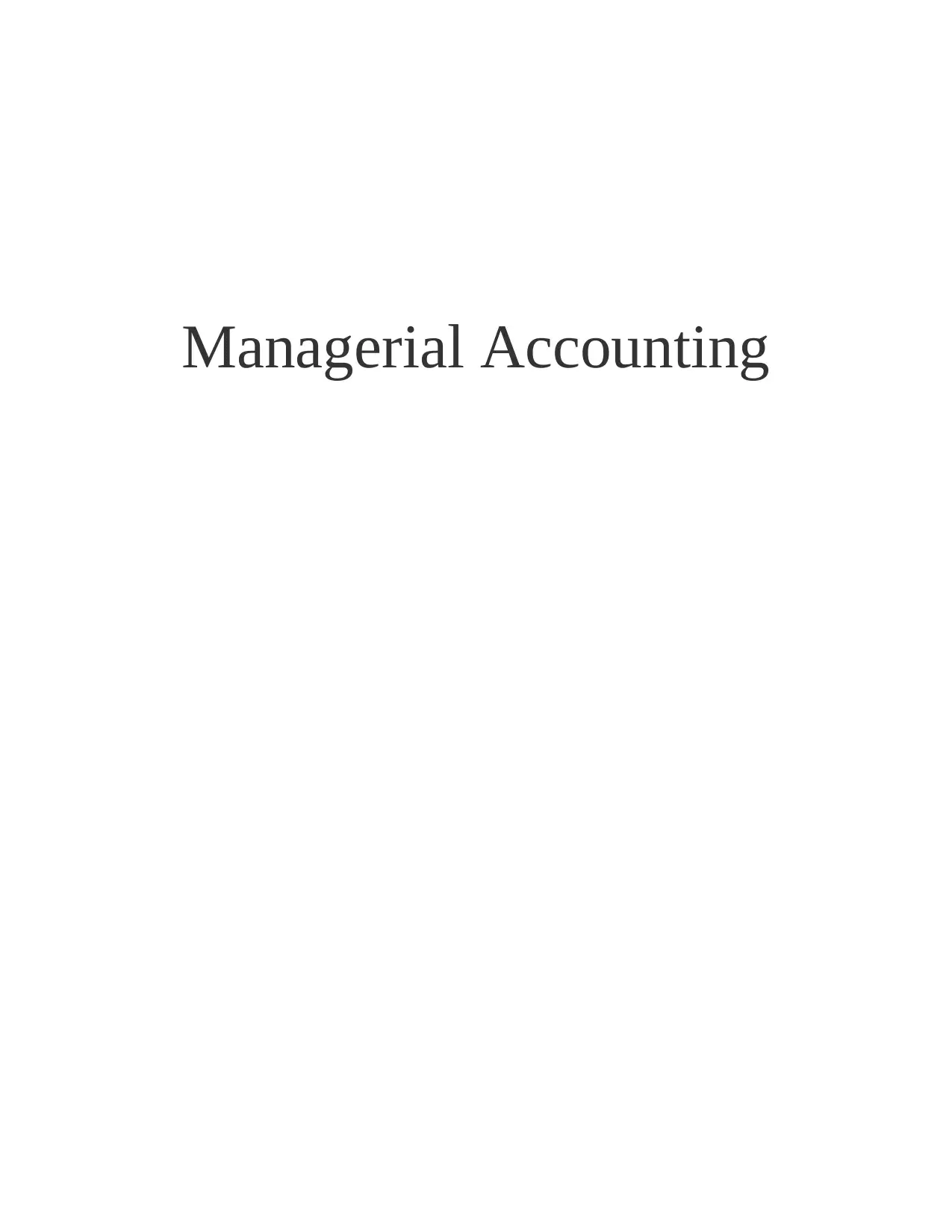
Managerial Accounting
Paraphrase This Document
Need a fresh take? Get an instant paraphrase of this document with our AI Paraphraser
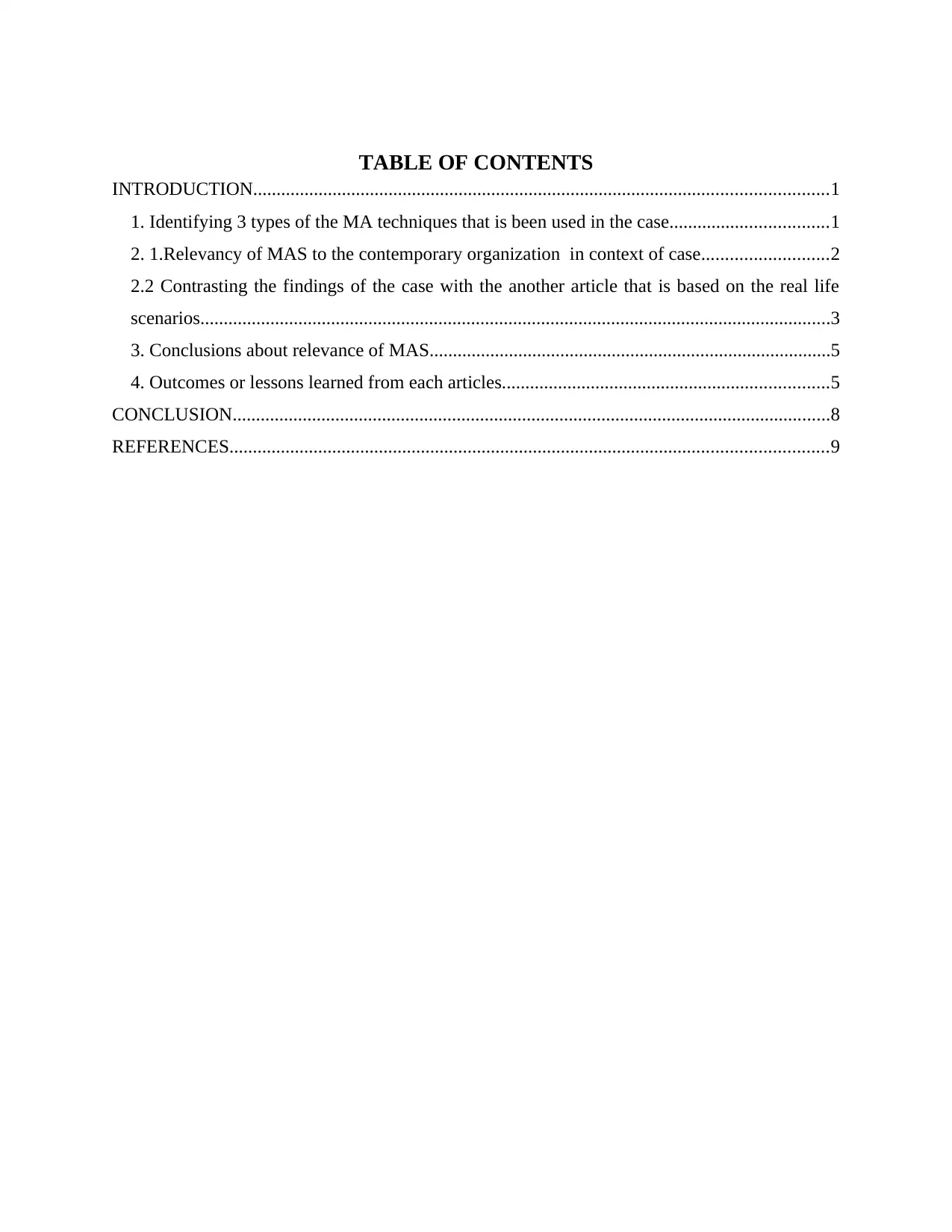
TABLE OF CONTENTS
INTRODUCTION...........................................................................................................................1
1. Identifying 3 types of the MA techniques that is been used in the case..................................1
2. 1.Relevancy of MAS to the contemporary organization in context of case...........................2
2.2 Contrasting the findings of the case with the another article that is based on the real life
scenarios.......................................................................................................................................3
3. Conclusions about relevance of MAS......................................................................................5
4. Outcomes or lessons learned from each articles......................................................................5
CONCLUSION................................................................................................................................8
REFERENCES................................................................................................................................9
INTRODUCTION...........................................................................................................................1
1. Identifying 3 types of the MA techniques that is been used in the case..................................1
2. 1.Relevancy of MAS to the contemporary organization in context of case...........................2
2.2 Contrasting the findings of the case with the another article that is based on the real life
scenarios.......................................................................................................................................3
3. Conclusions about relevance of MAS......................................................................................5
4. Outcomes or lessons learned from each articles......................................................................5
CONCLUSION................................................................................................................................8
REFERENCES................................................................................................................................9
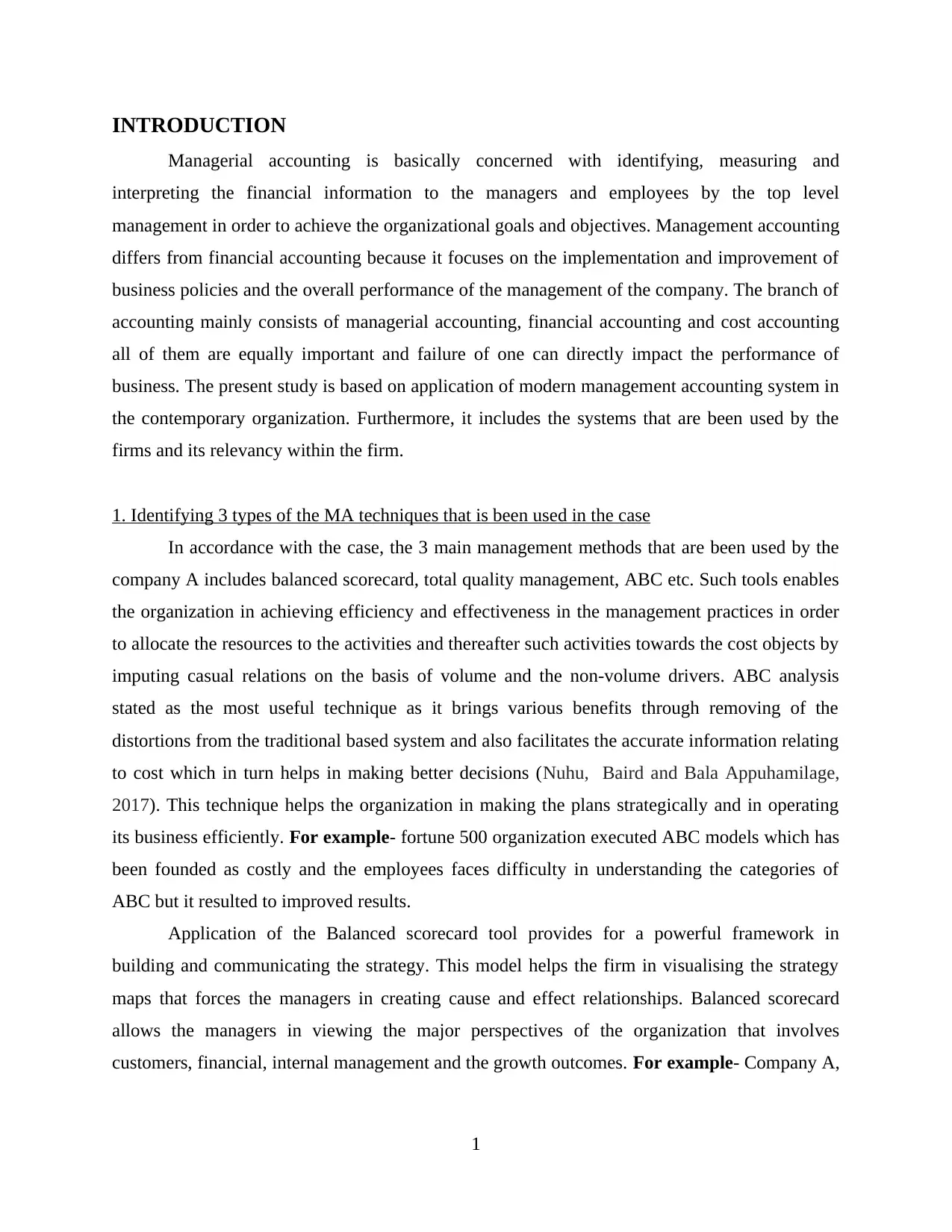
INTRODUCTION
Managerial accounting is basically concerned with identifying, measuring and
interpreting the financial information to the managers and employees by the top level
management in order to achieve the organizational goals and objectives. Management accounting
differs from financial accounting because it focuses on the implementation and improvement of
business policies and the overall performance of the management of the company. The branch of
accounting mainly consists of managerial accounting, financial accounting and cost accounting
all of them are equally important and failure of one can directly impact the performance of
business. The present study is based on application of modern management accounting system in
the contemporary organization. Furthermore, it includes the systems that are been used by the
firms and its relevancy within the firm.
1. Identifying 3 types of the MA techniques that is been used in the case
In accordance with the case, the 3 main management methods that are been used by the
company A includes balanced scorecard, total quality management, ABC etc. Such tools enables
the organization in achieving efficiency and effectiveness in the management practices in order
to allocate the resources to the activities and thereafter such activities towards the cost objects by
imputing casual relations on the basis of volume and the non-volume drivers. ABC analysis
stated as the most useful technique as it brings various benefits through removing of the
distortions from the traditional based system and also facilitates the accurate information relating
to cost which in turn helps in making better decisions (Nuhu, Baird and Bala Appuhamilage,
2017). This technique helps the organization in making the plans strategically and in operating
its business efficiently. For example- fortune 500 organization executed ABC models which has
been founded as costly and the employees faces difficulty in understanding the categories of
ABC but it resulted to improved results.
Application of the Balanced scorecard tool provides for a powerful framework in
building and communicating the strategy. This model helps the firm in visualising the strategy
maps that forces the managers in creating cause and effect relationships. Balanced scorecard
allows the managers in viewing the major perspectives of the organization that involves
customers, financial, internal management and the growth outcomes. For example- Company A,
1
Managerial accounting is basically concerned with identifying, measuring and
interpreting the financial information to the managers and employees by the top level
management in order to achieve the organizational goals and objectives. Management accounting
differs from financial accounting because it focuses on the implementation and improvement of
business policies and the overall performance of the management of the company. The branch of
accounting mainly consists of managerial accounting, financial accounting and cost accounting
all of them are equally important and failure of one can directly impact the performance of
business. The present study is based on application of modern management accounting system in
the contemporary organization. Furthermore, it includes the systems that are been used by the
firms and its relevancy within the firm.
1. Identifying 3 types of the MA techniques that is been used in the case
In accordance with the case, the 3 main management methods that are been used by the
company A includes balanced scorecard, total quality management, ABC etc. Such tools enables
the organization in achieving efficiency and effectiveness in the management practices in order
to allocate the resources to the activities and thereafter such activities towards the cost objects by
imputing casual relations on the basis of volume and the non-volume drivers. ABC analysis
stated as the most useful technique as it brings various benefits through removing of the
distortions from the traditional based system and also facilitates the accurate information relating
to cost which in turn helps in making better decisions (Nuhu, Baird and Bala Appuhamilage,
2017). This technique helps the organization in making the plans strategically and in operating
its business efficiently. For example- fortune 500 organization executed ABC models which has
been founded as costly and the employees faces difficulty in understanding the categories of
ABC but it resulted to improved results.
Application of the Balanced scorecard tool provides for a powerful framework in
building and communicating the strategy. This model helps the firm in visualising the strategy
maps that forces the managers in creating cause and effect relationships. Balanced scorecard
allows the managers in viewing the major perspectives of the organization that involves
customers, financial, internal management and the growth outcomes. For example- Company A,
1
⊘ This is a preview!⊘
Do you want full access?
Subscribe today to unlock all pages.

Trusted by 1+ million students worldwide
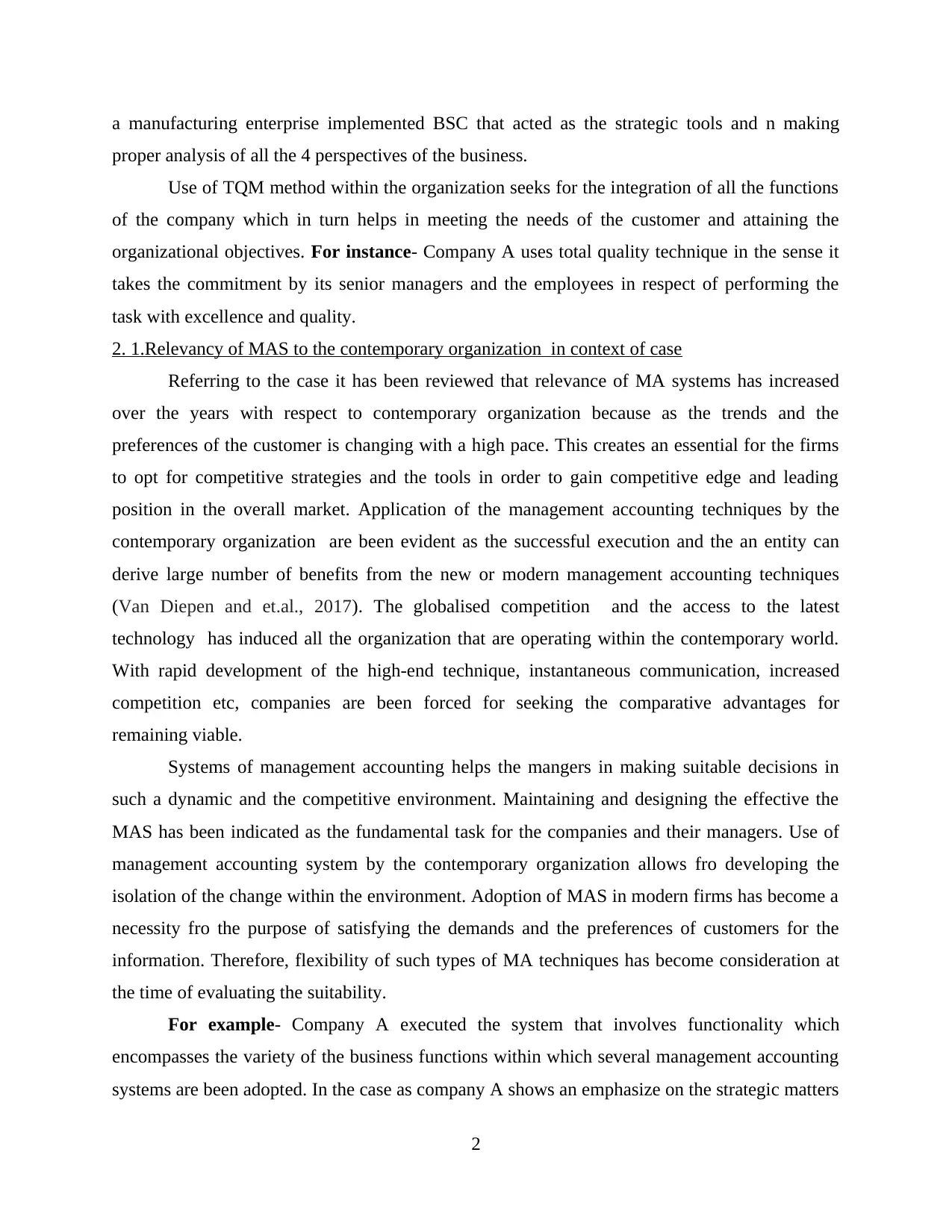
a manufacturing enterprise implemented BSC that acted as the strategic tools and n making
proper analysis of all the 4 perspectives of the business.
Use of TQM method within the organization seeks for the integration of all the functions
of the company which in turn helps in meeting the needs of the customer and attaining the
organizational objectives. For instance- Company A uses total quality technique in the sense it
takes the commitment by its senior managers and the employees in respect of performing the
task with excellence and quality.
2. 1.Relevancy of MAS to the contemporary organization in context of case
Referring to the case it has been reviewed that relevance of MA systems has increased
over the years with respect to contemporary organization because as the trends and the
preferences of the customer is changing with a high pace. This creates an essential for the firms
to opt for competitive strategies and the tools in order to gain competitive edge and leading
position in the overall market. Application of the management accounting techniques by the
contemporary organization are been evident as the successful execution and the an entity can
derive large number of benefits from the new or modern management accounting techniques
(Van Diepen and et.al., 2017). The globalised competition and the access to the latest
technology has induced all the organization that are operating within the contemporary world.
With rapid development of the high-end technique, instantaneous communication, increased
competition etc, companies are been forced for seeking the comparative advantages for
remaining viable.
Systems of management accounting helps the mangers in making suitable decisions in
such a dynamic and the competitive environment. Maintaining and designing the effective the
MAS has been indicated as the fundamental task for the companies and their managers. Use of
management accounting system by the contemporary organization allows fro developing the
isolation of the change within the environment. Adoption of MAS in modern firms has become a
necessity fro the purpose of satisfying the demands and the preferences of customers for the
information. Therefore, flexibility of such types of MA techniques has become consideration at
the time of evaluating the suitability.
For example- Company A executed the system that involves functionality which
encompasses the variety of the business functions within which several management accounting
systems are been adopted. In the case as company A shows an emphasize on the strategic matters
2
proper analysis of all the 4 perspectives of the business.
Use of TQM method within the organization seeks for the integration of all the functions
of the company which in turn helps in meeting the needs of the customer and attaining the
organizational objectives. For instance- Company A uses total quality technique in the sense it
takes the commitment by its senior managers and the employees in respect of performing the
task with excellence and quality.
2. 1.Relevancy of MAS to the contemporary organization in context of case
Referring to the case it has been reviewed that relevance of MA systems has increased
over the years with respect to contemporary organization because as the trends and the
preferences of the customer is changing with a high pace. This creates an essential for the firms
to opt for competitive strategies and the tools in order to gain competitive edge and leading
position in the overall market. Application of the management accounting techniques by the
contemporary organization are been evident as the successful execution and the an entity can
derive large number of benefits from the new or modern management accounting techniques
(Van Diepen and et.al., 2017). The globalised competition and the access to the latest
technology has induced all the organization that are operating within the contemporary world.
With rapid development of the high-end technique, instantaneous communication, increased
competition etc, companies are been forced for seeking the comparative advantages for
remaining viable.
Systems of management accounting helps the mangers in making suitable decisions in
such a dynamic and the competitive environment. Maintaining and designing the effective the
MAS has been indicated as the fundamental task for the companies and their managers. Use of
management accounting system by the contemporary organization allows fro developing the
isolation of the change within the environment. Adoption of MAS in modern firms has become a
necessity fro the purpose of satisfying the demands and the preferences of customers for the
information. Therefore, flexibility of such types of MA techniques has become consideration at
the time of evaluating the suitability.
For example- Company A executed the system that involves functionality which
encompasses the variety of the business functions within which several management accounting
systems are been adopted. In the case as company A shows an emphasize on the strategic matters
2
Paraphrase This Document
Need a fresh take? Get an instant paraphrase of this document with our AI Paraphraser
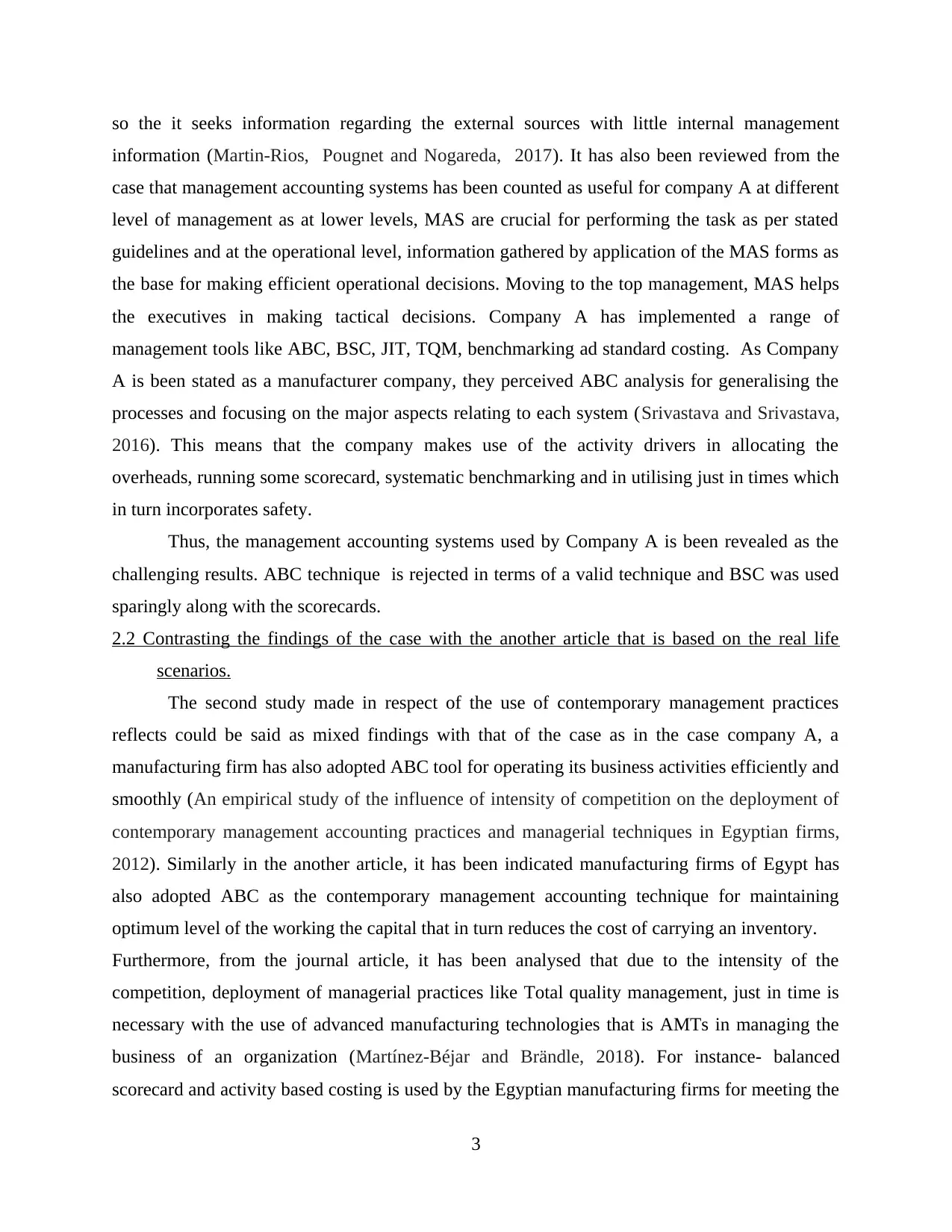
so the it seeks information regarding the external sources with little internal management
information (Martin-Rios, Pougnet and Nogareda, 2017). It has also been reviewed from the
case that management accounting systems has been counted as useful for company A at different
level of management as at lower levels, MAS are crucial for performing the task as per stated
guidelines and at the operational level, information gathered by application of the MAS forms as
the base for making efficient operational decisions. Moving to the top management, MAS helps
the executives in making tactical decisions. Company A has implemented a range of
management tools like ABC, BSC, JIT, TQM, benchmarking ad standard costing. As Company
A is been stated as a manufacturer company, they perceived ABC analysis for generalising the
processes and focusing on the major aspects relating to each system (Srivastava and Srivastava,
2016). This means that the company makes use of the activity drivers in allocating the
overheads, running some scorecard, systematic benchmarking and in utilising just in times which
in turn incorporates safety.
Thus, the management accounting systems used by Company A is been revealed as the
challenging results. ABC technique is rejected in terms of a valid technique and BSC was used
sparingly along with the scorecards.
2.2 Contrasting the findings of the case with the another article that is based on the real life
scenarios.
The second study made in respect of the use of contemporary management practices
reflects could be said as mixed findings with that of the case as in the case company A, a
manufacturing firm has also adopted ABC tool for operating its business activities efficiently and
smoothly (An empirical study of the influence of intensity of competition on the deployment of
contemporary management accounting practices and managerial techniques in Egyptian firms,
2012). Similarly in the another article, it has been indicated manufacturing firms of Egypt has
also adopted ABC as the contemporary management accounting technique for maintaining
optimum level of the working the capital that in turn reduces the cost of carrying an inventory.
Furthermore, from the journal article, it has been analysed that due to the intensity of the
competition, deployment of managerial practices like Total quality management, just in time is
necessary with the use of advanced manufacturing technologies that is AMTs in managing the
business of an organization (Martínez-Béjar and Brändle, 2018). For instance- balanced
scorecard and activity based costing is used by the Egyptian manufacturing firms for meeting the
3
information (Martin-Rios, Pougnet and Nogareda, 2017). It has also been reviewed from the
case that management accounting systems has been counted as useful for company A at different
level of management as at lower levels, MAS are crucial for performing the task as per stated
guidelines and at the operational level, information gathered by application of the MAS forms as
the base for making efficient operational decisions. Moving to the top management, MAS helps
the executives in making tactical decisions. Company A has implemented a range of
management tools like ABC, BSC, JIT, TQM, benchmarking ad standard costing. As Company
A is been stated as a manufacturer company, they perceived ABC analysis for generalising the
processes and focusing on the major aspects relating to each system (Srivastava and Srivastava,
2016). This means that the company makes use of the activity drivers in allocating the
overheads, running some scorecard, systematic benchmarking and in utilising just in times which
in turn incorporates safety.
Thus, the management accounting systems used by Company A is been revealed as the
challenging results. ABC technique is rejected in terms of a valid technique and BSC was used
sparingly along with the scorecards.
2.2 Contrasting the findings of the case with the another article that is based on the real life
scenarios.
The second study made in respect of the use of contemporary management practices
reflects could be said as mixed findings with that of the case as in the case company A, a
manufacturing firm has also adopted ABC tool for operating its business activities efficiently and
smoothly (An empirical study of the influence of intensity of competition on the deployment of
contemporary management accounting practices and managerial techniques in Egyptian firms,
2012). Similarly in the another article, it has been indicated manufacturing firms of Egypt has
also adopted ABC as the contemporary management accounting technique for maintaining
optimum level of the working the capital that in turn reduces the cost of carrying an inventory.
Furthermore, from the journal article, it has been analysed that due to the intensity of the
competition, deployment of managerial practices like Total quality management, just in time is
necessary with the use of advanced manufacturing technologies that is AMTs in managing the
business of an organization (Martínez-Béjar and Brändle, 2018). For instance- balanced
scorecard and activity based costing is used by the Egyptian manufacturing firms for meeting the
3
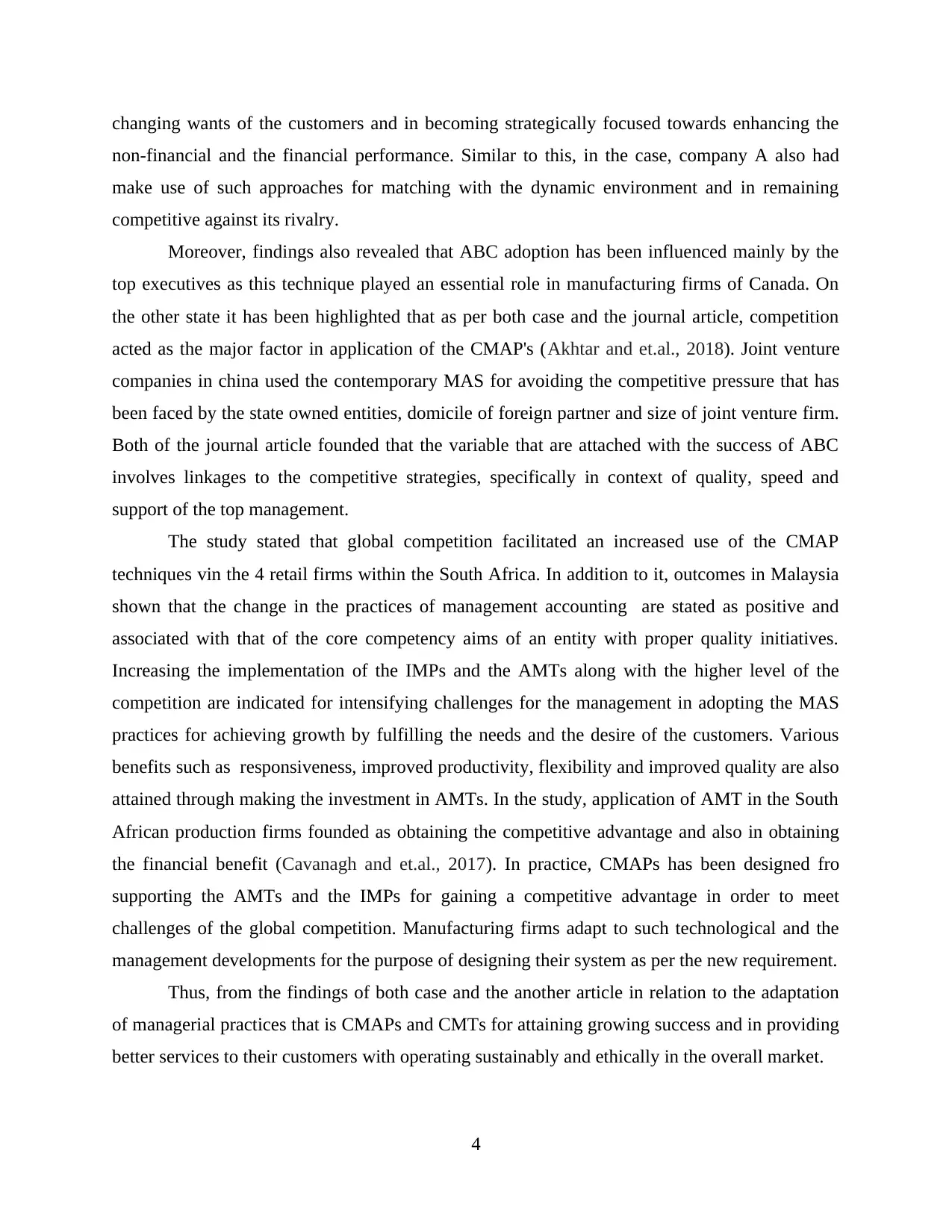
changing wants of the customers and in becoming strategically focused towards enhancing the
non-financial and the financial performance. Similar to this, in the case, company A also had
make use of such approaches for matching with the dynamic environment and in remaining
competitive against its rivalry.
Moreover, findings also revealed that ABC adoption has been influenced mainly by the
top executives as this technique played an essential role in manufacturing firms of Canada. On
the other state it has been highlighted that as per both case and the journal article, competition
acted as the major factor in application of the CMAP's (Akhtar and et.al., 2018). Joint venture
companies in china used the contemporary MAS for avoiding the competitive pressure that has
been faced by the state owned entities, domicile of foreign partner and size of joint venture firm.
Both of the journal article founded that the variable that are attached with the success of ABC
involves linkages to the competitive strategies, specifically in context of quality, speed and
support of the top management.
The study stated that global competition facilitated an increased use of the CMAP
techniques vin the 4 retail firms within the South Africa. In addition to it, outcomes in Malaysia
shown that the change in the practices of management accounting are stated as positive and
associated with that of the core competency aims of an entity with proper quality initiatives.
Increasing the implementation of the IMPs and the AMTs along with the higher level of the
competition are indicated for intensifying challenges for the management in adopting the MAS
practices for achieving growth by fulfilling the needs and the desire of the customers. Various
benefits such as responsiveness, improved productivity, flexibility and improved quality are also
attained through making the investment in AMTs. In the study, application of AMT in the South
African production firms founded as obtaining the competitive advantage and also in obtaining
the financial benefit (Cavanagh and et.al., 2017). In practice, CMAPs has been designed fro
supporting the AMTs and the IMPs for gaining a competitive advantage in order to meet
challenges of the global competition. Manufacturing firms adapt to such technological and the
management developments for the purpose of designing their system as per the new requirement.
Thus, from the findings of both case and the another article in relation to the adaptation
of managerial practices that is CMAPs and CMTs for attaining growing success and in providing
better services to their customers with operating sustainably and ethically in the overall market.
4
non-financial and the financial performance. Similar to this, in the case, company A also had
make use of such approaches for matching with the dynamic environment and in remaining
competitive against its rivalry.
Moreover, findings also revealed that ABC adoption has been influenced mainly by the
top executives as this technique played an essential role in manufacturing firms of Canada. On
the other state it has been highlighted that as per both case and the journal article, competition
acted as the major factor in application of the CMAP's (Akhtar and et.al., 2018). Joint venture
companies in china used the contemporary MAS for avoiding the competitive pressure that has
been faced by the state owned entities, domicile of foreign partner and size of joint venture firm.
Both of the journal article founded that the variable that are attached with the success of ABC
involves linkages to the competitive strategies, specifically in context of quality, speed and
support of the top management.
The study stated that global competition facilitated an increased use of the CMAP
techniques vin the 4 retail firms within the South Africa. In addition to it, outcomes in Malaysia
shown that the change in the practices of management accounting are stated as positive and
associated with that of the core competency aims of an entity with proper quality initiatives.
Increasing the implementation of the IMPs and the AMTs along with the higher level of the
competition are indicated for intensifying challenges for the management in adopting the MAS
practices for achieving growth by fulfilling the needs and the desire of the customers. Various
benefits such as responsiveness, improved productivity, flexibility and improved quality are also
attained through making the investment in AMTs. In the study, application of AMT in the South
African production firms founded as obtaining the competitive advantage and also in obtaining
the financial benefit (Cavanagh and et.al., 2017). In practice, CMAPs has been designed fro
supporting the AMTs and the IMPs for gaining a competitive advantage in order to meet
challenges of the global competition. Manufacturing firms adapt to such technological and the
management developments for the purpose of designing their system as per the new requirement.
Thus, from the findings of both case and the another article in relation to the adaptation
of managerial practices that is CMAPs and CMTs for attaining growing success and in providing
better services to their customers with operating sustainably and ethically in the overall market.
4
⊘ This is a preview!⊘
Do you want full access?
Subscribe today to unlock all pages.

Trusted by 1+ million students worldwide
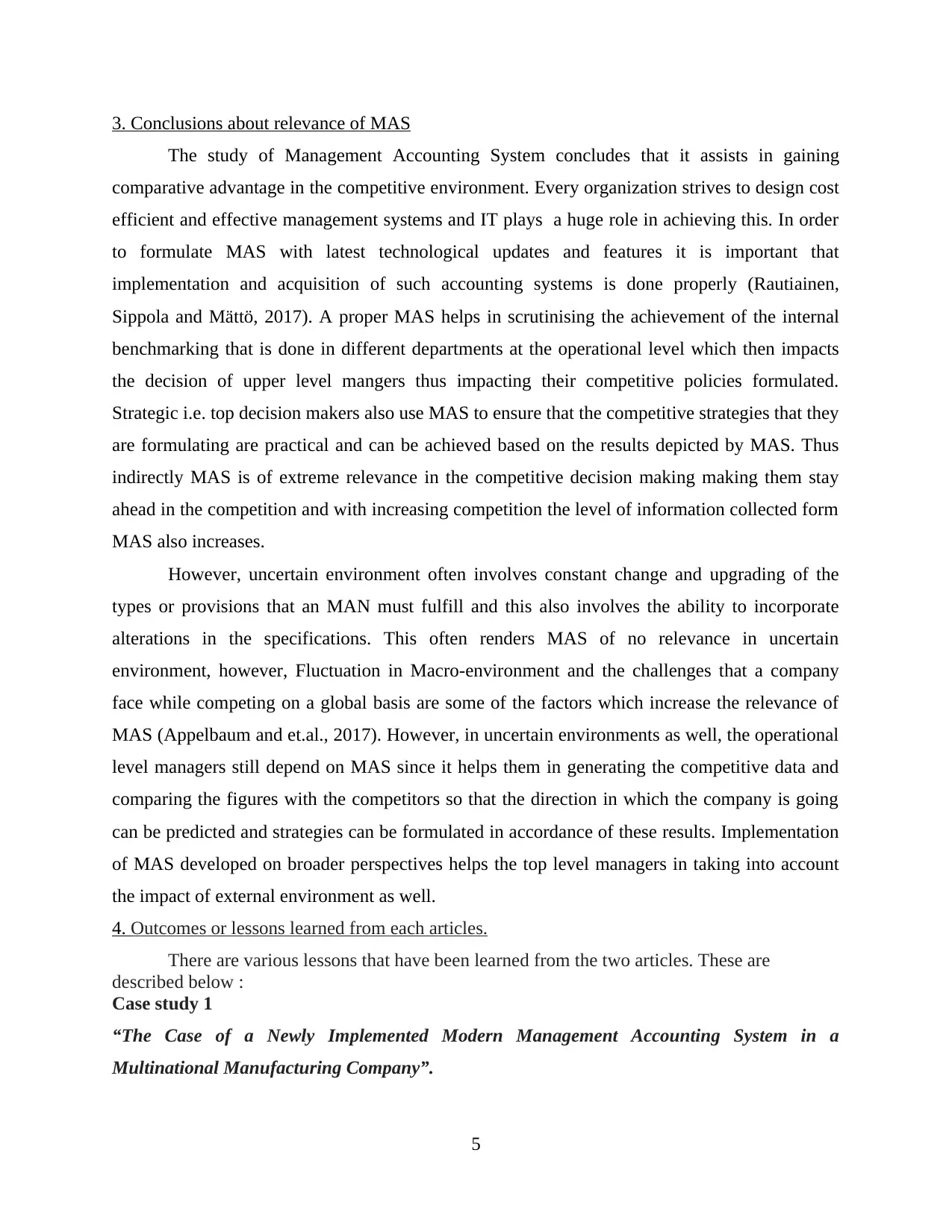
3. Conclusions about relevance of MAS
The study of Management Accounting System concludes that it assists in gaining
comparative advantage in the competitive environment. Every organization strives to design cost
efficient and effective management systems and IT plays a huge role in achieving this. In order
to formulate MAS with latest technological updates and features it is important that
implementation and acquisition of such accounting systems is done properly (Rautiainen,
Sippola and Mättö, 2017). A proper MAS helps in scrutinising the achievement of the internal
benchmarking that is done in different departments at the operational level which then impacts
the decision of upper level mangers thus impacting their competitive policies formulated.
Strategic i.e. top decision makers also use MAS to ensure that the competitive strategies that they
are formulating are practical and can be achieved based on the results depicted by MAS. Thus
indirectly MAS is of extreme relevance in the competitive decision making making them stay
ahead in the competition and with increasing competition the level of information collected form
MAS also increases.
However, uncertain environment often involves constant change and upgrading of the
types or provisions that an MAN must fulfill and this also involves the ability to incorporate
alterations in the specifications. This often renders MAS of no relevance in uncertain
environment, however, Fluctuation in Macro-environment and the challenges that a company
face while competing on a global basis are some of the factors which increase the relevance of
MAS (Appelbaum and et.al., 2017). However, in uncertain environments as well, the operational
level managers still depend on MAS since it helps them in generating the competitive data and
comparing the figures with the competitors so that the direction in which the company is going
can be predicted and strategies can be formulated in accordance of these results. Implementation
of MAS developed on broader perspectives helps the top level managers in taking into account
the impact of external environment as well.
4. Outcomes or lessons learned from each articles.
There are various lessons that have been learned from the two articles. These are
described below :
Case study 1
“The Case of a Newly Implemented Modern Management Accounting System in a
Multinational Manufacturing Company”.
5
The study of Management Accounting System concludes that it assists in gaining
comparative advantage in the competitive environment. Every organization strives to design cost
efficient and effective management systems and IT plays a huge role in achieving this. In order
to formulate MAS with latest technological updates and features it is important that
implementation and acquisition of such accounting systems is done properly (Rautiainen,
Sippola and Mättö, 2017). A proper MAS helps in scrutinising the achievement of the internal
benchmarking that is done in different departments at the operational level which then impacts
the decision of upper level mangers thus impacting their competitive policies formulated.
Strategic i.e. top decision makers also use MAS to ensure that the competitive strategies that they
are formulating are practical and can be achieved based on the results depicted by MAS. Thus
indirectly MAS is of extreme relevance in the competitive decision making making them stay
ahead in the competition and with increasing competition the level of information collected form
MAS also increases.
However, uncertain environment often involves constant change and upgrading of the
types or provisions that an MAN must fulfill and this also involves the ability to incorporate
alterations in the specifications. This often renders MAS of no relevance in uncertain
environment, however, Fluctuation in Macro-environment and the challenges that a company
face while competing on a global basis are some of the factors which increase the relevance of
MAS (Appelbaum and et.al., 2017). However, in uncertain environments as well, the operational
level managers still depend on MAS since it helps them in generating the competitive data and
comparing the figures with the competitors so that the direction in which the company is going
can be predicted and strategies can be formulated in accordance of these results. Implementation
of MAS developed on broader perspectives helps the top level managers in taking into account
the impact of external environment as well.
4. Outcomes or lessons learned from each articles.
There are various lessons that have been learned from the two articles. These are
described below :
Case study 1
“The Case of a Newly Implemented Modern Management Accounting System in a
Multinational Manufacturing Company”.
5
Paraphrase This Document
Need a fresh take? Get an instant paraphrase of this document with our AI Paraphraser
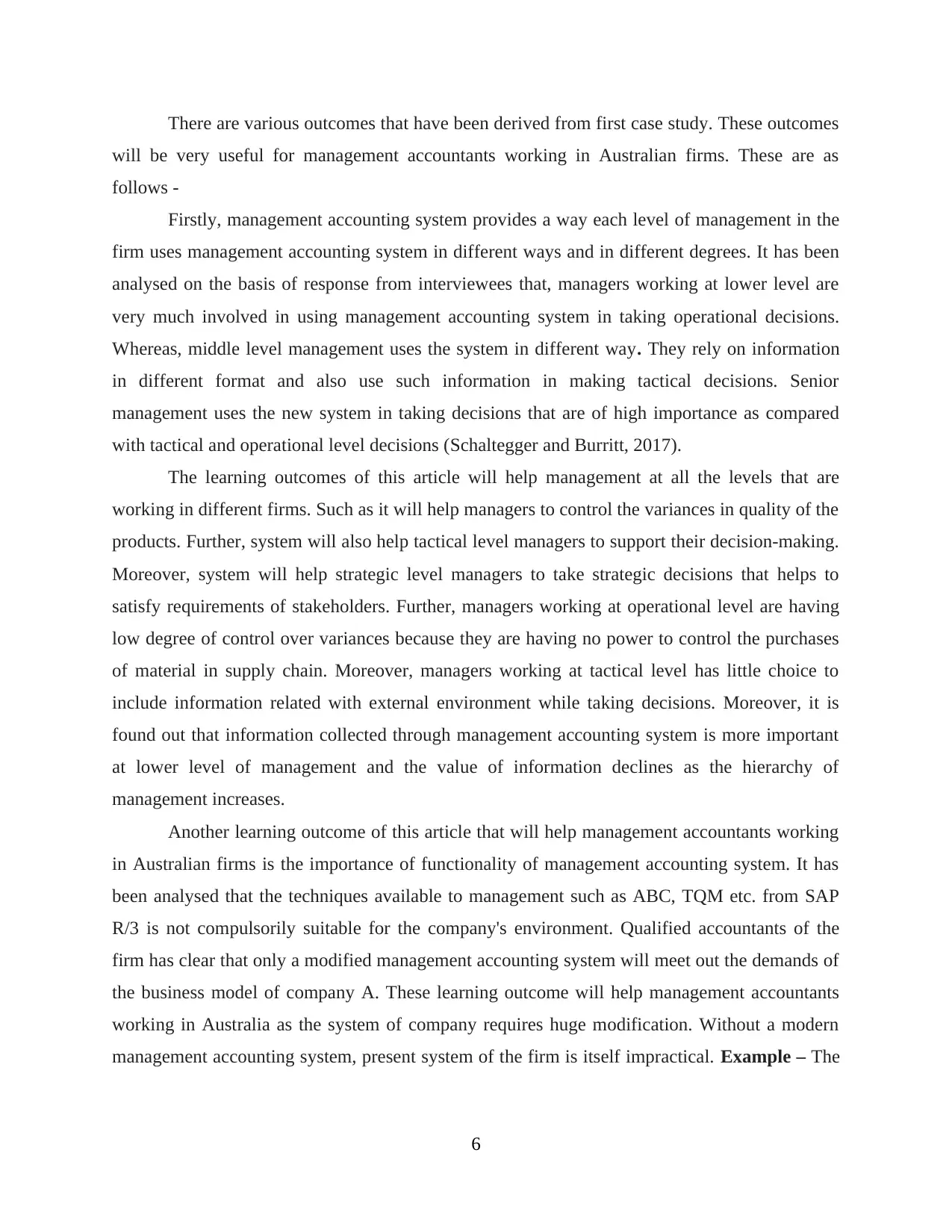
There are various outcomes that have been derived from first case study. These outcomes
will be very useful for management accountants working in Australian firms. These are as
follows -
Firstly, management accounting system provides a way each level of management in the
firm uses management accounting system in different ways and in different degrees. It has been
analysed on the basis of response from interviewees that, managers working at lower level are
very much involved in using management accounting system in taking operational decisions.
Whereas, middle level management uses the system in different way. They rely on information
in different format and also use such information in making tactical decisions. Senior
management uses the new system in taking decisions that are of high importance as compared
with tactical and operational level decisions (Schaltegger and Burritt, 2017).
The learning outcomes of this article will help management at all the levels that are
working in different firms. Such as it will help managers to control the variances in quality of the
products. Further, system will also help tactical level managers to support their decision-making.
Moreover, system will help strategic level managers to take strategic decisions that helps to
satisfy requirements of stakeholders. Further, managers working at operational level are having
low degree of control over variances because they are having no power to control the purchases
of material in supply chain. Moreover, managers working at tactical level has little choice to
include information related with external environment while taking decisions. Moreover, it is
found out that information collected through management accounting system is more important
at lower level of management and the value of information declines as the hierarchy of
management increases.
Another learning outcome of this article that will help management accountants working
in Australian firms is the importance of functionality of management accounting system. It has
been analysed that the techniques available to management such as ABC, TQM etc. from SAP
R/3 is not compulsorily suitable for the company's environment. Qualified accountants of the
firm has clear that only a modified management accounting system will meet out the demands of
the business model of company A. These learning outcome will help management accountants
working in Australia as the system of company requires huge modification. Without a modern
management accounting system, present system of the firm is itself impractical. Example – The
6
will be very useful for management accountants working in Australian firms. These are as
follows -
Firstly, management accounting system provides a way each level of management in the
firm uses management accounting system in different ways and in different degrees. It has been
analysed on the basis of response from interviewees that, managers working at lower level are
very much involved in using management accounting system in taking operational decisions.
Whereas, middle level management uses the system in different way. They rely on information
in different format and also use such information in making tactical decisions. Senior
management uses the new system in taking decisions that are of high importance as compared
with tactical and operational level decisions (Schaltegger and Burritt, 2017).
The learning outcomes of this article will help management at all the levels that are
working in different firms. Such as it will help managers to control the variances in quality of the
products. Further, system will also help tactical level managers to support their decision-making.
Moreover, system will help strategic level managers to take strategic decisions that helps to
satisfy requirements of stakeholders. Further, managers working at operational level are having
low degree of control over variances because they are having no power to control the purchases
of material in supply chain. Moreover, managers working at tactical level has little choice to
include information related with external environment while taking decisions. Moreover, it is
found out that information collected through management accounting system is more important
at lower level of management and the value of information declines as the hierarchy of
management increases.
Another learning outcome of this article that will help management accountants working
in Australian firms is the importance of functionality of management accounting system. It has
been analysed that the techniques available to management such as ABC, TQM etc. from SAP
R/3 is not compulsorily suitable for the company's environment. Qualified accountants of the
firm has clear that only a modified management accounting system will meet out the demands of
the business model of company A. These learning outcome will help management accountants
working in Australia as the system of company requires huge modification. Without a modern
management accounting system, present system of the firm is itself impractical. Example – The
6
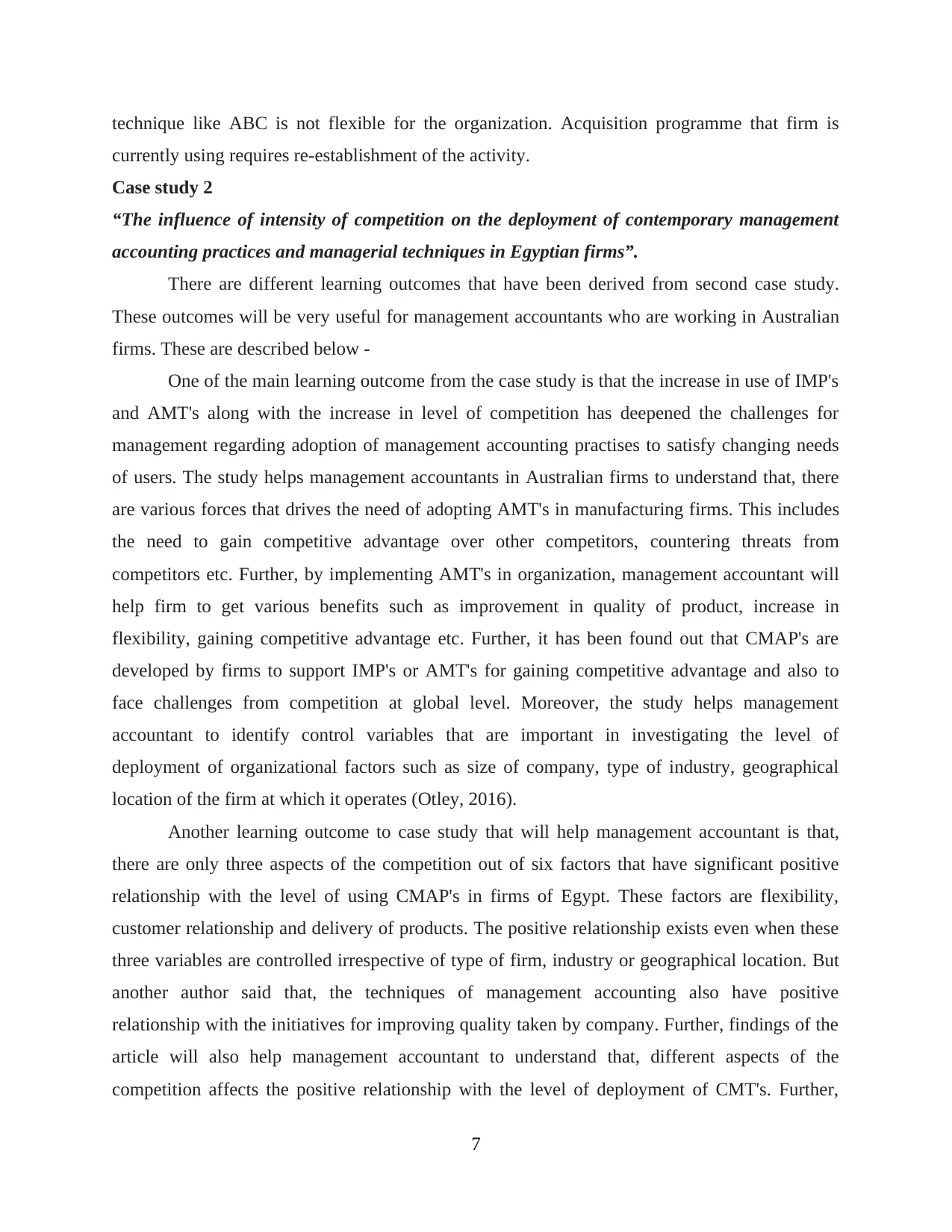
technique like ABC is not flexible for the organization. Acquisition programme that firm is
currently using requires re-establishment of the activity.
Case study 2
“The influence of intensity of competition on the deployment of contemporary management
accounting practices and managerial techniques in Egyptian firms”.
There are different learning outcomes that have been derived from second case study.
These outcomes will be very useful for management accountants who are working in Australian
firms. These are described below -
One of the main learning outcome from the case study is that the increase in use of IMP's
and AMT's along with the increase in level of competition has deepened the challenges for
management regarding adoption of management accounting practises to satisfy changing needs
of users. The study helps management accountants in Australian firms to understand that, there
are various forces that drives the need of adopting AMT's in manufacturing firms. This includes
the need to gain competitive advantage over other competitors, countering threats from
competitors etc. Further, by implementing AMT's in organization, management accountant will
help firm to get various benefits such as improvement in quality of product, increase in
flexibility, gaining competitive advantage etc. Further, it has been found out that CMAP's are
developed by firms to support IMP's or AMT's for gaining competitive advantage and also to
face challenges from competition at global level. Moreover, the study helps management
accountant to identify control variables that are important in investigating the level of
deployment of organizational factors such as size of company, type of industry, geographical
location of the firm at which it operates (Otley, 2016).
Another learning outcome to case study that will help management accountant is that,
there are only three aspects of the competition out of six factors that have significant positive
relationship with the level of using CMAP's in firms of Egypt. These factors are flexibility,
customer relationship and delivery of products. The positive relationship exists even when these
three variables are controlled irrespective of type of firm, industry or geographical location. But
another author said that, the techniques of management accounting also have positive
relationship with the initiatives for improving quality taken by company. Further, findings of the
article will also help management accountant to understand that, different aspects of the
competition affects the positive relationship with the level of deployment of CMT's. Further,
7
currently using requires re-establishment of the activity.
Case study 2
“The influence of intensity of competition on the deployment of contemporary management
accounting practices and managerial techniques in Egyptian firms”.
There are different learning outcomes that have been derived from second case study.
These outcomes will be very useful for management accountants who are working in Australian
firms. These are described below -
One of the main learning outcome from the case study is that the increase in use of IMP's
and AMT's along with the increase in level of competition has deepened the challenges for
management regarding adoption of management accounting practises to satisfy changing needs
of users. The study helps management accountants in Australian firms to understand that, there
are various forces that drives the need of adopting AMT's in manufacturing firms. This includes
the need to gain competitive advantage over other competitors, countering threats from
competitors etc. Further, by implementing AMT's in organization, management accountant will
help firm to get various benefits such as improvement in quality of product, increase in
flexibility, gaining competitive advantage etc. Further, it has been found out that CMAP's are
developed by firms to support IMP's or AMT's for gaining competitive advantage and also to
face challenges from competition at global level. Moreover, the study helps management
accountant to identify control variables that are important in investigating the level of
deployment of organizational factors such as size of company, type of industry, geographical
location of the firm at which it operates (Otley, 2016).
Another learning outcome to case study that will help management accountant is that,
there are only three aspects of the competition out of six factors that have significant positive
relationship with the level of using CMAP's in firms of Egypt. These factors are flexibility,
customer relationship and delivery of products. The positive relationship exists even when these
three variables are controlled irrespective of type of firm, industry or geographical location. But
another author said that, the techniques of management accounting also have positive
relationship with the initiatives for improving quality taken by company. Further, findings of the
article will also help management accountant to understand that, different aspects of the
competition affects the positive relationship with the level of deployment of CMT's. Further,
7
⊘ This is a preview!⊘
Do you want full access?
Subscribe today to unlock all pages.

Trusted by 1+ million students worldwide
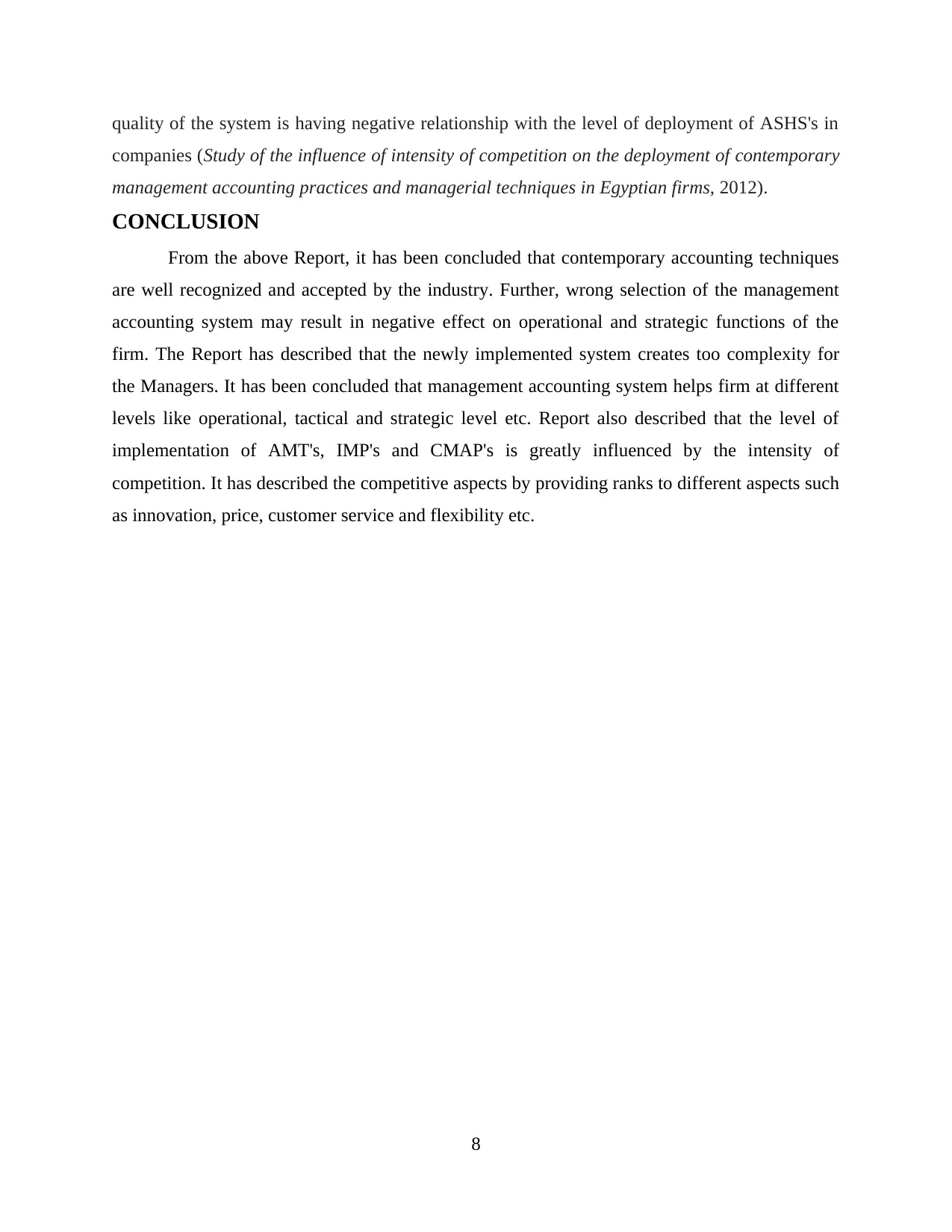
quality of the system is having negative relationship with the level of deployment of ASHS's in
companies (Study of the influence of intensity of competition on the deployment of contemporary
management accounting practices and managerial techniques in Egyptian firms, 2012).
CONCLUSION
From the above Report, it has been concluded that contemporary accounting techniques
are well recognized and accepted by the industry. Further, wrong selection of the management
accounting system may result in negative effect on operational and strategic functions of the
firm. The Report has described that the newly implemented system creates too complexity for
the Managers. It has been concluded that management accounting system helps firm at different
levels like operational, tactical and strategic level etc. Report also described that the level of
implementation of AMT's, IMP's and CMAP's is greatly influenced by the intensity of
competition. It has described the competitive aspects by providing ranks to different aspects such
as innovation, price, customer service and flexibility etc.
8
companies (Study of the influence of intensity of competition on the deployment of contemporary
management accounting practices and managerial techniques in Egyptian firms, 2012).
CONCLUSION
From the above Report, it has been concluded that contemporary accounting techniques
are well recognized and accepted by the industry. Further, wrong selection of the management
accounting system may result in negative effect on operational and strategic functions of the
firm. The Report has described that the newly implemented system creates too complexity for
the Managers. It has been concluded that management accounting system helps firm at different
levels like operational, tactical and strategic level etc. Report also described that the level of
implementation of AMT's, IMP's and CMAP's is greatly influenced by the intensity of
competition. It has described the competitive aspects by providing ranks to different aspects such
as innovation, price, customer service and flexibility etc.
8
Paraphrase This Document
Need a fresh take? Get an instant paraphrase of this document with our AI Paraphraser
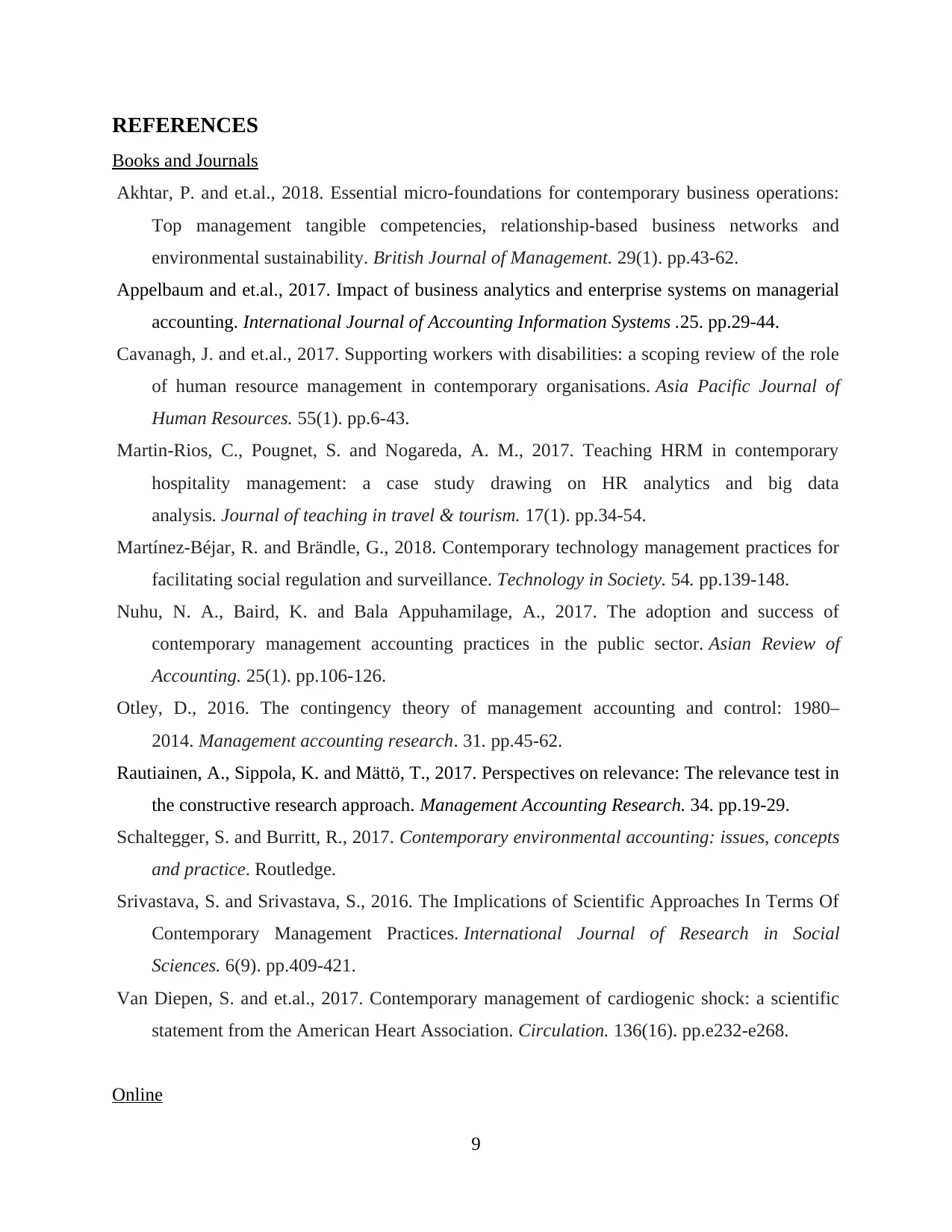
REFERENCES
Books and Journals
Akhtar, P. and et.al., 2018. Essential micro‐foundations for contemporary business operations:
Top management tangible competencies, relationship‐based business networks and
environmental sustainability. British Journal of Management. 29(1). pp.43-62.
Appelbaum and et.al., 2017. Impact of business analytics and enterprise systems on managerial
accounting. International Journal of Accounting Information Systems .25. pp.29-44.
Cavanagh, J. and et.al., 2017. Supporting workers with disabilities: a scoping review of the role
of human resource management in contemporary organisations. Asia Pacific Journal of
Human Resources. 55(1). pp.6-43.
Martin-Rios, C., Pougnet, S. and Nogareda, A. M., 2017. Teaching HRM in contemporary
hospitality management: a case study drawing on HR analytics and big data
analysis. Journal of teaching in travel & tourism. 17(1). pp.34-54.
Martínez-Béjar, R. and Brändle, G., 2018. Contemporary technology management practices for
facilitating social regulation and surveillance. Technology in Society. 54. pp.139-148.
Nuhu, N. A., Baird, K. and Bala Appuhamilage, A., 2017. The adoption and success of
contemporary management accounting practices in the public sector. Asian Review of
Accounting. 25(1). pp.106-126.
Otley, D., 2016. The contingency theory of management accounting and control: 1980–
2014. Management accounting research. 31. pp.45-62.
Rautiainen, A., Sippola, K. and Mättö, T., 2017. Perspectives on relevance: The relevance test in
the constructive research approach. Management Accounting Research. 34. pp.19-29.
Schaltegger, S. and Burritt, R., 2017. Contemporary environmental accounting: issues, concepts
and practice. Routledge.
Srivastava, S. and Srivastava, S., 2016. The Implications of Scientific Approaches In Terms Of
Contemporary Management Practices. International Journal of Research in Social
Sciences. 6(9). pp.409-421.
Van Diepen, S. and et.al., 2017. Contemporary management of cardiogenic shock: a scientific
statement from the American Heart Association. Circulation. 136(16). pp.e232-e268.
Online
9
Books and Journals
Akhtar, P. and et.al., 2018. Essential micro‐foundations for contemporary business operations:
Top management tangible competencies, relationship‐based business networks and
environmental sustainability. British Journal of Management. 29(1). pp.43-62.
Appelbaum and et.al., 2017. Impact of business analytics and enterprise systems on managerial
accounting. International Journal of Accounting Information Systems .25. pp.29-44.
Cavanagh, J. and et.al., 2017. Supporting workers with disabilities: a scoping review of the role
of human resource management in contemporary organisations. Asia Pacific Journal of
Human Resources. 55(1). pp.6-43.
Martin-Rios, C., Pougnet, S. and Nogareda, A. M., 2017. Teaching HRM in contemporary
hospitality management: a case study drawing on HR analytics and big data
analysis. Journal of teaching in travel & tourism. 17(1). pp.34-54.
Martínez-Béjar, R. and Brändle, G., 2018. Contemporary technology management practices for
facilitating social regulation and surveillance. Technology in Society. 54. pp.139-148.
Nuhu, N. A., Baird, K. and Bala Appuhamilage, A., 2017. The adoption and success of
contemporary management accounting practices in the public sector. Asian Review of
Accounting. 25(1). pp.106-126.
Otley, D., 2016. The contingency theory of management accounting and control: 1980–
2014. Management accounting research. 31. pp.45-62.
Rautiainen, A., Sippola, K. and Mättö, T., 2017. Perspectives on relevance: The relevance test in
the constructive research approach. Management Accounting Research. 34. pp.19-29.
Schaltegger, S. and Burritt, R., 2017. Contemporary environmental accounting: issues, concepts
and practice. Routledge.
Srivastava, S. and Srivastava, S., 2016. The Implications of Scientific Approaches In Terms Of
Contemporary Management Practices. International Journal of Research in Social
Sciences. 6(9). pp.409-421.
Van Diepen, S. and et.al., 2017. Contemporary management of cardiogenic shock: a scientific
statement from the American Heart Association. Circulation. 136(16). pp.e232-e268.
Online
9
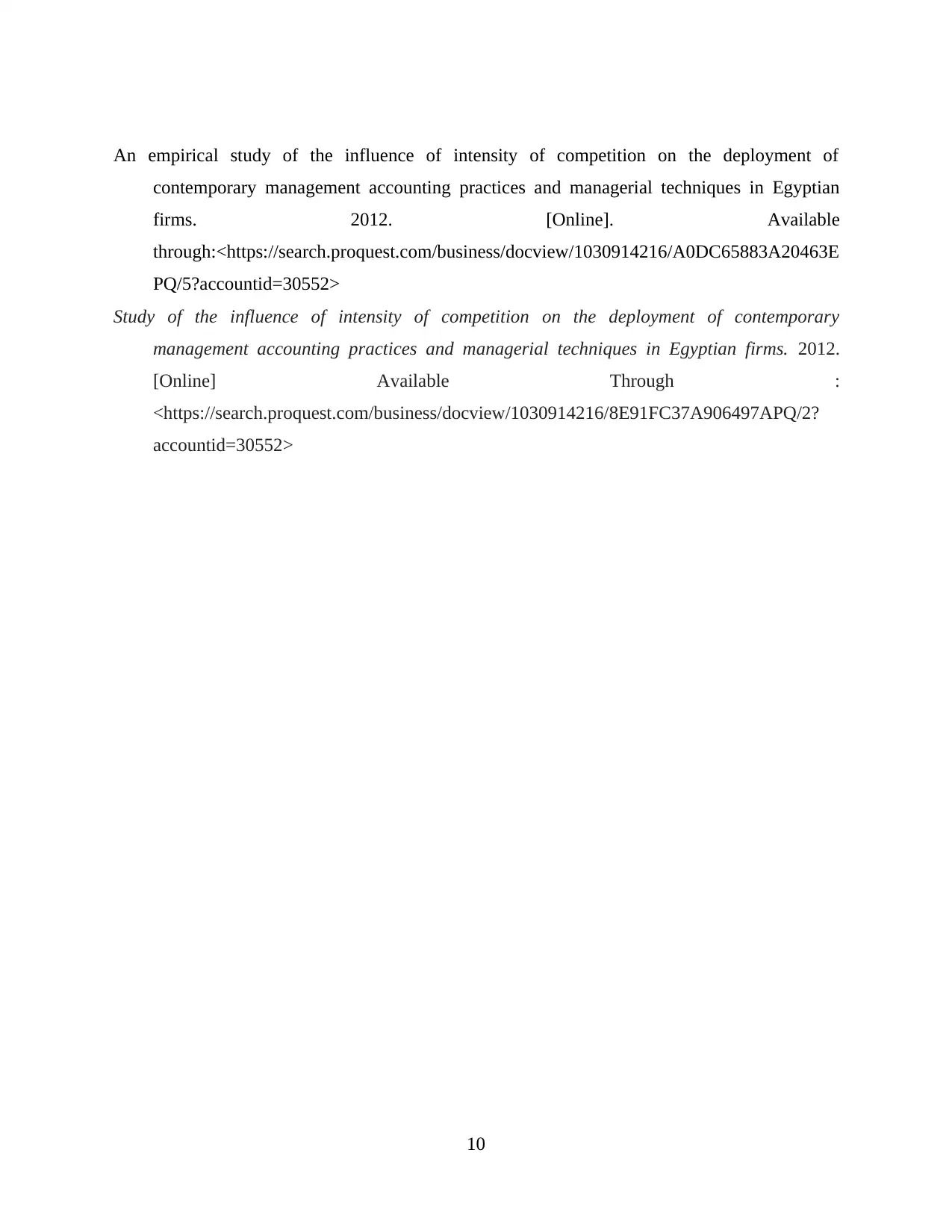
An empirical study of the influence of intensity of competition on the deployment of
contemporary management accounting practices and managerial techniques in Egyptian
firms. 2012. [Online]. Available
through:<https://search.proquest.com/business/docview/1030914216/A0DC65883A20463E
PQ/5?accountid=30552>
Study of the influence of intensity of competition on the deployment of contemporary
management accounting practices and managerial techniques in Egyptian firms. 2012.
[Online] Available Through :
<https://search.proquest.com/business/docview/1030914216/8E91FC37A906497APQ/2?
accountid=30552>
10
contemporary management accounting practices and managerial techniques in Egyptian
firms. 2012. [Online]. Available
through:<https://search.proquest.com/business/docview/1030914216/A0DC65883A20463E
PQ/5?accountid=30552>
Study of the influence of intensity of competition on the deployment of contemporary
management accounting practices and managerial techniques in Egyptian firms. 2012.
[Online] Available Through :
<https://search.proquest.com/business/docview/1030914216/8E91FC37A906497APQ/2?
accountid=30552>
10
⊘ This is a preview!⊘
Do you want full access?
Subscribe today to unlock all pages.

Trusted by 1+ million students worldwide
1 out of 12
Related Documents
Your All-in-One AI-Powered Toolkit for Academic Success.
+13062052269
info@desklib.com
Available 24*7 on WhatsApp / Email
![[object Object]](/_next/static/media/star-bottom.7253800d.svg)
Unlock your academic potential
Copyright © 2020–2025 A2Z Services. All Rights Reserved. Developed and managed by ZUCOL.





